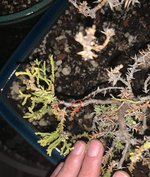Strudel
Seed
Hi guys I've had this tree for about a decade and, within the past few months, it deteriorated pretty quickly and then completely stopped going bad -- about 2/3 of the tree seems to have died off, and 1/3 of it looks okay but hasn't gotten any worse or better. The fact that the condition hasn't worsened or improved makes me think dormancy? Since it's spring now, I repotted it just a few days ago but I'm not sure what else to do, since I'm not sure if the issue is disease, a root issue, a sun issue, or a watering issue. Additionally, it did have a tiny bit of new growth at the beginning of spring, but only where the rest of the greenery already is. It really seems like 2/3 is just dead. For what it's worth, I keep it outside year-round in southern California and water 2x a week max. I have some photos so if anyone has any input or suggestions, or questions, please let me know
I've had this tree for about a decade and, within the past few months, it deteriorated pretty quickly and then completely stopped going bad -- about 2/3 of the tree seems to have died off, and 1/3 of it looks okay but hasn't gotten any worse or better. The fact that the condition hasn't worsened or improved makes me think dormancy? Since it's spring now, I repotted it just a few days ago but I'm not sure what else to do, since I'm not sure if the issue is disease, a root issue, a sun issue, or a watering issue. Additionally, it did have a tiny bit of new growth at the beginning of spring, but only where the rest of the greenery already is. It really seems like 2/3 is just dead. For what it's worth, I keep it outside year-round in southern California and water 2x a week max. I have some photos so if anyone has any input or suggestions, or questions, please let me know






